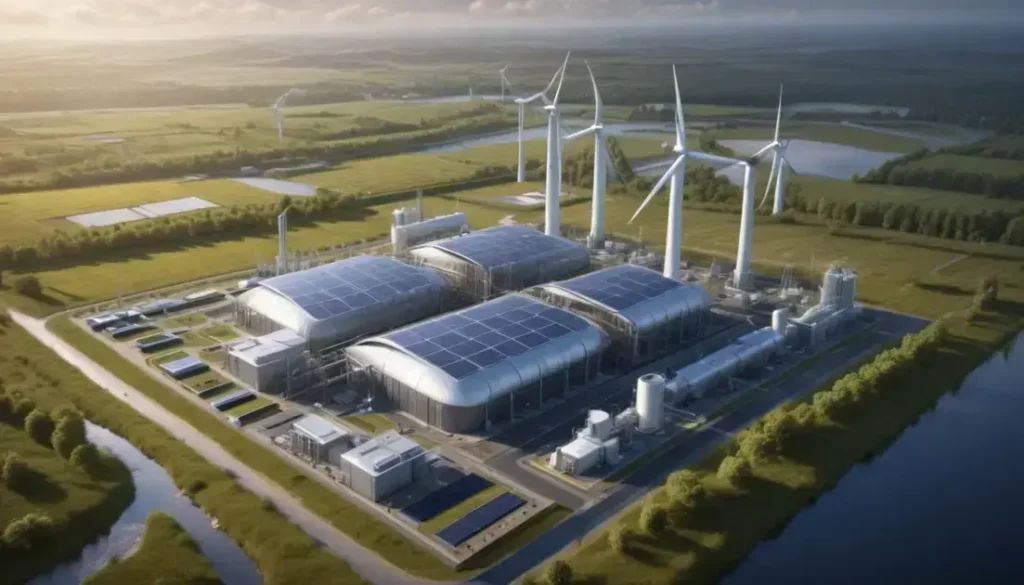Women play a crucial role in achieving environmental goals by leading initiatives in sustainability, advocating for inclusive policies, and implementing innovative solutions in various sectors.
On International Women in Engineering Day, we highlight the significance of women in engineering and their contributions to a more sustainable future.
Introduction to Women in Engineering Day
International Women in Engineering Day celebrates the contributions of women in the engineering field. It highlights the importance of diversity in engineering and emphasizes how women bring unique perspectives to problem-solving. Encouraging women to enter and thrive in this typically male-dominated profession is essential for fostering innovation.
Engaging resources such as mentorship programs and scholarships can significantly enhance recruitment and retention rates of female engineers. By focusing on flexibility in work arrangements and creating inclusive environments, industries can attract a greater number of talented women.
Furthermore, showcasing successful female engineers as role models can inspire the next generation. Institutions and companies should highlight their achievements to demonstrate the impact of women in engineering. This visibility not only motivates young girls to pursue STEM careers but also builds a stronger, more diverse workforce.
In addition to outreach efforts, addressing workplace biases is crucial. Training programs that educate employees on inclusivity and unconscious bias can create a healthier work culture. Such initiatives pave the way for continuous growth and adaptation in the engineering sector, ultimately benefiting all of society.
Importance of retention in engineering
Retention of engineers is critical for maintaining a competitive edge in the industry. High turnover rates can lead to significant losses, including decreased productivity and increased recruitment costs. Companies must focus on creating an engaging work environment to ensure engineers feel valued and motivated.
Professional development opportunities play a vital role in retaining engineering talent. Employers should invest in training programs that enhance skills and encourage career growth. These initiatives provide engineers with the tools they need to innovate and excel in their roles.
Additionally, implementing programs that support work-life balance can significantly affect retention rates. Flexible work schedules and the option for remote work create a supportive atmosphere where engineers can thrive both personally and professionally.
Recognizing achievements and providing adequate compensation are also essential. Celebrating accomplishments fosters a sense of belonging and helps build a loyal workforce. Regular feedback and open communication channels can reinforce this connection, allowing engineers to feel heard and appreciated.
Ultimately, prioritizing retention strategies will enable engineering firms to sustain their growth and improve project outcomes by capitalizing on the expertise of their experienced workforce.
Global gender balance in engineering
The global gender balance in engineering remains a pressing issue, with women comprising only a fraction of the workforce. Promoting gender diversity is essential for fostering innovation and enhancing problem-solving capabilities in various engineering disciplines. Diverse teams bring unique perspectives that can lead to groundbreaking solutions in technology and infrastructure.
Creating strategies to improve this balance starts with education. Encouraging young girls to explore STEM fields from an early age can significantly impact their future career choices. Schools and communities can implement programs that highlight female role models in engineering, inspiring the next generation to pursue these paths.
Additionally, industries must address systemic barriers that hinder women’s participation in engineering. Companies should prioritize inclusive hiring practices and promote workplace cultures that value diversity. Implementing mentorship programs can also help support women engineers as they navigate challenges in their careers.
Globally, initiatives like the UN Women’s HeForShe campaign encourage men to be allies in promoting gender equality in engineering. By fostering an inclusive atmosphere, businesses can not only comply with equality standards but also boost their overall performance and innovation.
Efforts to enhance gender balance in engineering are crucial for building a sustainable and equitable future. A more balanced workforce will lead to more innovative solutions and improved outcomes for society.
Flexibility and inclusion in the workplace
Flexibility and inclusion in the workplace are essential for enhancing employee satisfaction and productivity. Offering flexible work arrangements, such as remote work options and adjustable hours, empowers employees to balance their personal and professional lives effectively. This approach not only helps in retaining top talent but also attracts a more diverse workforce.
A supportive work environment fosters inclusivity, enabling all employees, regardless of their background, to contribute meaningfully. Organizations should implement policies that promote diversity and actively address any barriers that employees may face. Creating Employee Resource Groups (ERGs) can provide a platform for underrepresented voices and encourage collaboration among team members.
Moreover, promoting open communication can significantly enhance workplace culture. Regular check-ins between management and staff can help understand individual needs and preferences, making employees feel valued and heard. Implementing feedback mechanisms allows for continuous improvement in workplace policies.
Training programs focusing on unconscious bias and cultural competency are crucial for cultivating an inclusive atmosphere. Educating employees about diversity and inclusion principles can lead to improved teamwork and innovation, benefiting the entire organization.
Ultimately, by embracing flexibility and prioritizing inclusion, companies can create an environment where all employees can thrive. This commitment not only enhances employee morale but also drives overall business success.
Impact of sustainable practices
The impact of sustainable practices in engineering is profound, influencing not just the environment but also the economic viability of projects. By adopting eco-friendly methods, companies can reduce their carbon footprint and promote resource conservation. Sustainable engineering practices often lead to energy efficiency, which results in lower operational costs.
Implementing green technologies is essential for future-proofing engineering projects. This includes using sustainable materials, optimizing energy use, and integrating renewable energy sources. Such practices contribute to the development of structures and products that are not only efficient but also environmentally responsible.
Furthermore, companies embracing sustainability can enhance their brand reputation. Customers are increasingly favoring businesses that demonstrate a commitment to environmental responsibility. This shift in consumer behavior makes sustainability a crucial factor for competitive advantage in the marketplace.
Beyond consumer preference, sustainable engineering practices can also lead to regulatory compliance. Governments worldwide are implementing stricter environmental regulations, and companies that adapt to these changes proactively can avoid potential penalties and legal issues.
Incorporating sustainable practices into engineering is a win-win for both the environment and business success. By prioritizing sustainability, engineers can contribute to a healthier planet while achieving long-term economic benefits for their organizations.
Innovative engineering solutions
Innovative engineering solutions play a crucial role in addressing complex global challenges. By leveraging cutting-edge technologies, engineers can design systems that enhance efficiency and sustainability. These solutions often incorporate smart technologies and data analytics to optimize performance and minimize waste.
One area of innovation is in renewable energy systems. Engineers are developing advanced solar panels and wind turbines that maximize energy capture while minimizing the environmental footprint. These technologies not only provide cleaner energy sources but also contribute to the reduction of greenhouse gas emissions.
Another significant advancement is in smart city infrastructure. Integrating technologies such as IoT and AI into urban planning allows cities to better manage resources, enhance public services, and improve the quality of life for residents. Smart traffic systems, for instance, can reduce congestion and lower pollution levels.
In the field of materials science, engineers are exploring sustainable materials like bioplastics and recycled composites. These materials offer similar performance levels to traditional materials but with a much lower impact on the environment, paving the way for greener construction methods.
Overall, innovative engineering solutions are pivotal for creating a sustainable future. By embracing technological advancements, engineers can meet the evolving demands of society while contributing to global sustainability efforts.
Role of mentorship in engineering careers
The role of mentorship in engineering careers is invaluable, providing guidance and support to young professionals navigating their paths. Mentorship facilitates knowledge transfer from experienced engineers to newcomers, equipping them with essential skills and insights. This relationship fosters a sense of belonging and enhances confidence in the workplace.
Mentors serve as role models, sharing their experiences and helping mentees set realistic career goals. They provide constructive feedback that can significantly improve an engineer’s performance and help them overcome challenges. Through regular interactions, mentors encourage mentees to ask questions, explore new opportunities, and expand their professional networks.
Moreover, mentorship promotes a culture of continuous learning. As engineers face rapidly changing technologies and methodologies, having a mentor who is updated with industry trends can be crucial. This relationship not only benefits the mentee but also allows mentors to refine their leadership skills and gain fresh perspectives on their practices.
Companies that implement formal mentorship programs often see higher retention rates and improved employee satisfaction. By investing in such initiatives, organizations cultivate a supportive environment that values development and inclusivity. Ultimately, strong mentorship connections can be a game changer in shaping successful careers in engineering.
Hybrid work models and talent retention
Hybrid work models have emerged as a popular solution for balancing employee needs and organizational goals. These models allow employees to split their time between remote work and in-office presence, enhancing flexibility and job satisfaction. Companies adopting hybrid models often see improved talent retention as employees appreciate the ability to tailor their work environments.
One significant benefit of hybrid work arrangements is the ability to accommodate diverse work styles. Some employees thrive in collaborative office settings, while others perform best in quiet, remote environments. By providing options, firms can attract a broader range of talent and foster a more inclusive workplace culture.
Moreover, hybrid work can contribute to productivity gains. Employees who work remotely may experience fewer distractions, leading to higher concentration and efficiency. Organizations can capitalize on this by implementing clear communication practices that support both remote and in-office employees.
Implementing a hybrid work model requires thoughtful planning to ensure all employees feel connected and engaged. Regular team meetings, virtual events, and feedback loops can help maintain team cohesion. By prioritizing a supportive environment, companies can reduce turnover rates and enhance employee morale.
Ultimately, effective hybrid work models not only benefit employees but also drive organizational success, making them an essential strategy in today’s competitive job market.
Women leading in environmental goals
Women are increasingly taking on leadership roles in driving environmental goals and sustainability initiatives across various sectors. Their contributions are vital in addressing climate change and promoting ecological balance. Empowering women to lead in these areas not only enhances decision-making but also brings diverse perspectives that are crucial for effective solutions.
Across the globe, female leaders are spearheading innovative projects aimed at reducing carbon footprints and enhancing resource efficiency. Their efforts in fields such as renewable energy, waste management, and conservation are laying the groundwork for a more sustainable future. By championing green technologies and practices, these women serve as role models, inspiring future generations to engage in environmentally responsible actions.
Furthermore, women in leadership positions can impact policy decisions related to environmental regulations and practices. Their advocacy is essential for promoting inclusive policies that consider the needs of marginalized communities, ensuring that sustainability efforts are equitable and just.
Networking and support structures, such as mentorship programs, are pivotal in helping women navigate their careers in environmental fields. By fostering collaboration among women leaders and sharing resources, communities can build a stronger movement toward achieving environmental goals.
Building a future-ready workforce
Building a future-ready workforce is essential for organizations aiming to maintain relevance in an ever-changing marketplace. As industries evolve, the demand for adaptable skills increases. Companies must invest in employee development programs that enhance competencies and prepare workers for the challenges of tomorrow.
One effective strategy is to implement ongoing training and educational initiatives. These programs should focus on emerging technologies, critical thinking, and collaboration skills, enabling employees to thrive in dynamic environments. By encouraging lifelong learning, organizations can cultivate a culture that embraces innovation and agility.
Furthermore, partnerships with educational institutions can bridge the skills gap. Collaborating with universities and vocational schools allows companies to influence curriculums that align with industry needs. This proactive approach ensures that graduates are equipped with the tools necessary to enter the workforce successfully.
In addition to technical skills, organizations should prioritize soft skills like communication, creativity, and emotional intelligence. These attributes are vital for fostering teamwork and driving engagement. By blending technical training with personal development, companies can create a holistic workforce that is well-prepared for future challenges.
Ultimately, investing in a future-ready workforce not only enhances productivity but also positions organizations as leaders in their industries, ensuring long-term success.
Conclusions and call to action
In the rapidly evolving landscape of engineering and environmental sustainability, collective effort is crucial. Engineers must embrace innovation and adaptability to address pressing global challenges like climate change. By integrating sustainable practices, professionals can significantly minimize their ecological impact and contribute to a healthier planet.
Organizations should foster a culture that prioritizes diversity and inclusion. Empowering women and underrepresented groups in engineering fosters creativity and leads to more comprehensive solutions. Mentorship programs can play a vital role in guiding these individuals toward leadership positions, ensuring that diverse perspectives are considered in decision-making.
Furthermore, promoting education and continuous learning is essential. Industries must align their training programs with emerging trends and technologies. By investing in employee development, organizations can prepare their workforce for the future while enhancing employee satisfaction and retention.
As stakeholders in the engineering community, everyone has a role to play in advocating for these changes. Join organizations, participate in discussions, and engage in initiatives that support sustainable engineering practices. Together, we can build a better future that prioritizes innovation, equity, and environmental stewardship.
In Conclusion: Shaping a Sustainable Future
Building a future that prioritizes sustainability and inclusivity is a shared responsibility. By focusing on mentoring, promoting women in leadership, and implementing hybrid work models, we can create an engineering landscape that thrives on innovation and diversity.
Organizations must commit to continuous learning and development, ensuring that employees are equipped with the skills needed to tackle future challenges. Together, we can pave the way for a workforce that is not only prepared but also inspired to make a positive impact on the environment.
As individuals and organizations, let us take actionable steps toward this goal. By collaborating and supporting one another, we can drive meaningful change and contribute to a healthier planet for future generations. Remember, every effort counts in this journey toward sustainability.
Frequently Asked Questions
How can mentorship improve my engineering career?
Mentorship provides guidance, support, and valuable insights from experienced professionals, helping you navigate challenges and grow in your career.
What are the benefits of hybrid work models?
Hybrid work models offer flexibility, allowing employees to balance work and personal life, which can lead to higher job satisfaction and retention rates.
Why is diversity important in engineering?
Diversity fosters innovation by bringing different perspectives and ideas, leading to more effective problem-solving and better project outcomes.
How can I stay updated on emerging engineering trends?
Engaging in continuous learning through workshops, online courses, and industry conferences can help you stay informed on the latest trends and technologies.
What role do women play in environmental sustainability?
Women are increasingly taking leadership roles in sustainability initiatives, driving efforts in renewable energy and advocating for equitable policies.
How can organizations promote inclusivity?
Organizations can promote inclusivity by implementing training programs, supporting diverse hiring practices, and creating mentorship opportunities for underrepresented groups.


